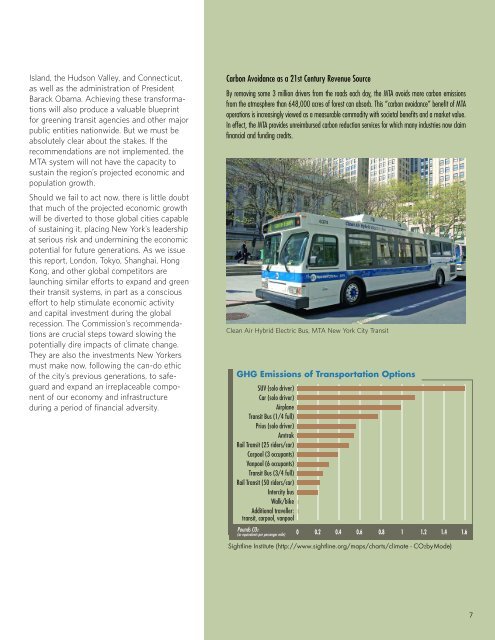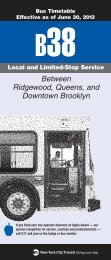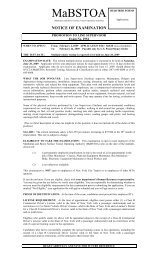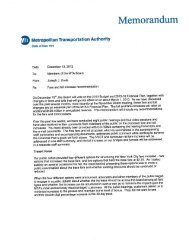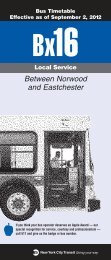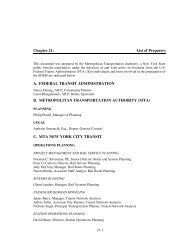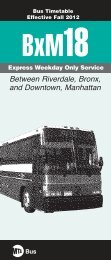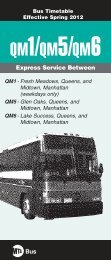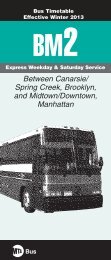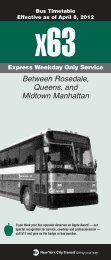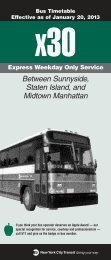Greening Mass Transit & Metro Regions: The Final Report - MTA
Greening Mass Transit & Metro Regions: The Final Report - MTA
Greening Mass Transit & Metro Regions: The Final Report - MTA
Create successful ePaper yourself
Turn your PDF publications into a flip-book with our unique Google optimized e-Paper software.
Island, the Hudson Valley, and Connecticut,<br />
as well as the administration of President<br />
Barack Obama. Achieving these transformations<br />
will also produce a valuable blueprint<br />
for greening transit agencies and other major<br />
public entities nationwide. But we must be<br />
absolutely clear about the stakes. If the<br />
recommendations are not implemented, the<br />
<strong>MTA</strong> system will not have the capacity to<br />
sustain the region’s projected economic and<br />
population growth.<br />
Should we fail to act now, there is little doubt<br />
that much of the projected economic growth<br />
will be diverted to those global cities capable<br />
of sustaining it, placing New York’s leadership<br />
at serious risk and undermining the economic<br />
potential for future generations. As we issue<br />
this report, London, Tokyo, Shanghai, Hong<br />
Kong, and other global competitors are<br />
launching similar efforts to expand and green<br />
their transit systems, in part as a conscious<br />
effort to help stimulate economic activity<br />
and capital investment during the global<br />
recession. <strong>The</strong> Commission’s recommendations<br />
are crucial steps toward slowing the<br />
potentially dire impacts of climate change.<br />
<strong>The</strong>y are also the investments New Yorkers<br />
must make now, following the can-do ethic<br />
of the city’s previous generations, to safeguard<br />
and expand an irreplaceable component<br />
of our economy and infrastructure<br />
during a period of financial adversity.<br />
Carbon Avoidance as a 21st Century Revenue Source<br />
By removing some 3 million drivers from the roads each day, the <strong>MTA</strong> avoids more carbon emissions<br />
from the atmosphere than 648,000 acres of forest can absorb. This “carbon avoidance” benefit of <strong>MTA</strong><br />
operations is increasingly viewed as a measurable commodity with societal benefits and a market value.<br />
In effect, the <strong>MTA</strong> provides unreimbursed carbon reduction services for which many industries now claim<br />
financial and funding credits.<br />
Clean Air Hybrid Electric Bus, <strong>MTA</strong> New York City <strong>Transit</strong><br />
GHG Emissions of Transportation Options<br />
SUV (solo driver)<br />
Car (solo driver)<br />
Airplane<br />
<strong>Transit</strong> Bus (1/4 full)<br />
Prius (solo driver)<br />
Amtrak<br />
Rail <strong>Transit</strong> (25 riders/car)<br />
Carpool (3 occupants)<br />
Vanpool (6 occupants)<br />
<strong>Transit</strong> Bus (3/4 full)<br />
Rail <strong>Transit</strong> (50 riders/car)<br />
Intercity bus<br />
Walk/bike<br />
Additional traveller:<br />
transit, carpool, vanpool<br />
Pounds CO2<br />
(or equivalents per passenger mile)<br />
0 0.2 0.4 0.6 0.8 1 1.2 1.4 1.6<br />
Sightline Institute (http://www.sightline.org/maps/charts/climate - CO2byMode)<br />
7


